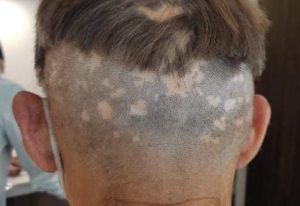About Hair Loss – Alopecia
There are many types of hair loss. Some types are temporary and some are permanent. Determining the type of hair loss someone is experiencing will help determine if the hair loss is permanent and treatable. Most cases of hair loss are due to genetics and can be treated if detected early, while hair transplantation provides a permanent solution to this particular problem.
The average person loses about 50-100 hairs a day. This is normal. While there is no particular number of hairs to determine an abnormal amount of hair loss, if someone begins to notice a large amount of hair on their pillow or comb, they should consult a doctor. This is especially the case if they start experiencing bald patches or thinning hair which can be signs of an underlying medical condition. There are many types of hair loss (also known as alopecia). Hair loss can be classified into two categories: alopecia universalis and alopecia areata.
Determination of the type of hair loss in order to form treatment options:
Before the recommended method of treatment, a doctor should determine what caused the hair loss. During the evaluation process, a doctor may ask if the hair loss is sudden or gradual, if the patient is on medication, has allergies, a family history of baldness, or if the patient is on a diet. If the patient is female, the doctor may ask the patient about her menstrual cycle, if she is pregnant, or if the patient is going through menopause.
Many times a doctor will inspect the scalp for an indication of hair loss. This is usually done by performing a pull test to determine the location and severity of the hair loss or by inspecting the hair on other parts of the body. Sometimes a doctor will collect a hair sample, perform a blood test or remove a small part of the scalp to get the necessary evidence (or scalp biopsy). Because there are so many different causes for hair loss, it can take time to determine the hair loss to be able to find an appropriate solution. In the majority of cases where medication does not produce the desired results, hair transplantation is the optimal method of restoring scalp density.
What causes thinning?
In follicles genetically predisposed to hair loss, a hormone called DHT (Dihydrotestosterone) causes the growth phase of the hair cycle to become shorter and shorter. This shorter growth window produces hair strands that are shorter in length and thinner in diameter with each hair cycle. For those who do not have AGA in their genes, DHT is not a threat to trigger pattern hair loss. Although medically benign, androgenetic alopecia can get progressively worse if left untreated.
Hair transplantation is considered an extremely important treatment, as the end result of this procedure will make a positive contribution especially to the physical appearance of women. In addition to the negative effects on physical appearance, hair loss can also lead to feelings of extreme psychological distress.
This condition affects women much more than men. It has also been observed that women tend to experience serious psychological problems such as feelings of inadequacy in a social setting, spending a lot of time and effort to hide bald patches, or having trouble accepting the condition of hair loss.
Causes of hair loss in women:
Hair loss in females, also known as androgenetic alopecia, is the most common cause of hair loss in women.
Other possible causes of hair loss in women are:
- Genetic predisposition to hair loss
- Autoimmune Diseases
- Change in hormone levels
- Medication
- Menopause
- Pregnancy
- Excessive stress
- Crash dieting/rapid weight loss
- Iron deficiency
Sudden hair loss in men.
Reasons
There are dozens of reasons behind sudden male pattern baldness. Here are some of the most common:
#1 Gyroid Alopecia

One of the most common reasons behind sudden hair fall among men. Gyroid alopecia is an autoimmune disease that causes small patches. It occurs when our immune system cells mistakenly attack the hair follicles.
The more hair follicles that are attacked by the immune system, the faster the hair loss is among men. Men suffering from gyroid alopecia usually lose hair on the scalp, but it could also affect the beard, eyelashes, eyebrows or armpits.
#2 Telogen Effluvium
The telogen effluvium is the second common reason for sudden hair loss among males. It is a short-term hair loss condition that usually occurs after stressful events. A person with a telogen effluvium will not lose all their hair, but the disorder of the density of the scalp hair may be noticeable.
The telogen effluvium disrupts the hair cycle in men. Our hair growth cycle, as a general rule, includes three phases – anagen (growth phase), catagen (transition phase) and telogen (resting phase). This hair loss condition shifts the hair from the regrowth phase to the telogen phase. With this condition, men will notice many split ends while washing or brushing their hair. One can also find hair in the sink or on the pillow.
#3 Nutritional deficiencies
We know that, right? Medicines are designed to support us through health conditions and diseases, but sometimes, they leave unwanted side effects. Hair loss is one of them. Sudden hair loss may occur within days or weeks after taking the drug. Medicines such as blood thinners and chemotherapy drugs are widely known to cause changes in hair color, texture and sudden hair loss among men. They cause hair loss by interfering with the normal growth cycle of scalp hair and prevent the matrix cells from shedding normally.
Treatment options for hereditary hair loss:
The trick to treating androgenetic alopecia (AGA) is to start early with prevention and intervention using medically approved treatment methods. There are three FDA-approved treatments for hereditary hair loss including finasteride (men only), minoxidil, and laser therapy. Side effects, efficacy, and ease of use should be considered when choosing a treatment option. Learn more about the different treatment options to help you make your decision.
Hair Transplantation: Hair Transplantation, offering a permanent solution to hair loss, is the process of extracting follicular units from the donor area (carried out at the back of the head). This is because the donor site is genetically resistant to baldness. The minimally invasive procedure yields successful results in women with permanent hair loss conditions as long as they have sufficient amounts of donor supply. Hair transplantation stands out as one of the most successful treatments for women experiencing localized or male pattern hair loss conditions, and Dr.Maria Skolarikou performs the procedure carefully with excellent results.
Pictured below are the results before and after the hair transplantation:
The price is determined below:
- For 500 hair follicles, i.e. up to 1.250 hairs, the cost is 600 – 1.200 euros
- For 1.000 hair follicles, i.e. up to 2.500 hairs, the cost is 1.200 – 2.00 euros
- For 1500 hair follicles, i.e. up to 3.750 hairs, the cost is 1.800 – 2.800 euros
- For 2000 hair follicles, i.e. up to 5.000 hairs, the cost is 2.400 – 3.600 euros
- For 2500 hair follicles, i.e. up to 6.250 hairs, the cost is 3.000 – 4.200 euros
- For 3000 hair follicles, i.e. up to 7.500 hairs, the cost is 3.600 – 5.000 euros
Depending on the doctor, the clinic and the technique, the final cost can be up to 15.000 euros.









